语言学导论第二章
- 格式:ppt
- 大小:1.15 MB
- 文档页数:50

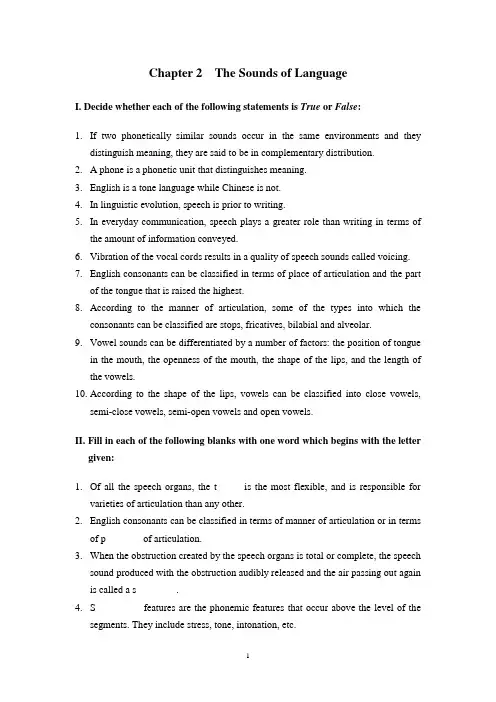
Chapter 2 The Sounds of LanguageI. Decide whether each of the following statements is True or False:1.If two phonetically similar sounds occur in the same environments and theydistinguish meaning, they are said to be in complementary distribution.2. A phone is a phonetic unit that distinguishes meaning.3.English is a tone language while Chinese is not.4.In linguistic evolution, speech is prior to writing.5.In everyday communication, speech plays a greater role than writing in terms ofthe amount of information conveyed.6.Vibration of the vocal cords results in a quality of speech sounds called voicing.7.English consonants can be classified in terms of place of articulation and the partof the tongue that is raised the highest.8.According to the manner of articulation, some of the types into which theconsonants can be classified are stops, fricatives, bilabial and alveolar.9.Vowel sounds can be differentiated by a number of factors: the position of tonguein the mouth, the openness of the mouth, the shape of the lips, and the length of the vowels.10.According to the shape of the lips, vowels can be classified into close vowels,semi-close vowels, semi-open vowels and open vowels.II. Fill in each of the following blanks with one word which begins with the letter given:1.Of all the speech organs, the t ____ is the most flexible, and is responsible forvarieties of articulation than any other.2.English consonants can be classified in terms of manner of articulation or in termsof p_______ of articulation.3.When the obstruction created by the speech organs is total or complete, the speechsound produced with the obstruction audibly released and the air passing out again is called a s________.4.S_________ features are the phonemic features that occur above the level of thesegments. They include stress, tone, intonation, etc.5.The rules that govern the combination of sounds in a particular language arecalled s____ rules.6.The transcription of speech sounds with letter-symbols only is called broadtranscription while the transcription with letter-symbols together with the diacritics is called n_________ transcription.7.When pitch, stress and sound length are tied to the sentence rather than the wordin isolation, they are collectively known as i_________.8.P___________ is a discipline which studies the system of sounds of a particularlanguage and how sounds are combined into meaningful units to effect linguistic communication.9.T_______ are pitch variations, which are caused by the differing rates of vibrationof the vocal cords and which can distinguish meaning just like phonemes.10.Depending on the context in which stress is considered, there are two kinds ofstress: word stress and s_________ stress.III. Define the terms below:1. phoneme2.allophone3. International Phonetic Alphabet4. intonation5. auditory phonetics6. acoustic phonetics7. minimal pairIV. Answer the following questions as comprehensively as possible. Give examples for illustration if necessary:1.What are the major differences between phonology and phonetics?2.Illustrate with examples how suprasegmental features can affect meaning.3.In what way can we determine whether a phone is a phoneme or not?Suggested AnswersI. 1. F 2. F 3. F 4.T 5. T 6. T 7. F 8. F 9. T 10. FII.1. tongue2. place3. stop4. Suprasegmental5. sequential6. narrow7. intonation8. Phonology9. Tone 10. sentenceIII.1.Phoneme: The basic unit in phonology is called phoneme; it is a unit of distinctivevalue. But it is an abstract unit. To be exact, a phoneme is not a sound; it is a collection of distinctive phonetic features.2.Allophone: The different phones which can represent a phoneme in differentphonetic environments are called the allophones of that phoneme.3.International phonetic alphabet: It is a standardized and internationally acceptedsystem of phonetic transcription.4.Intonation: When pitch, stress and sound length are tied to the sentence rather thanthe word in isolation, they are collectively known as intonation.5.Auditory phonetics: It studies the speech sounds from the hearer's point of view. Itstudies how the sounds are perceived by the hearer.6.Acoustic phonetics: It studies the speech sounds by looking at the sound waves. Itstudies the physical means by which speech sounds are transmitted through the air from one person to another.7.Minimal pair: When two different forms are identical in every way except for onesound segment which occurs in the same place in the strings, the two words are said to form a minimal pair.IV.1. They differ in their approach and focus. Phonetics is of a general nature; it isinterested in all the speech sounds used in all human languages: how they are produced, how they differ from each other, what phonetic features they possess, how they can be classified. Phonology, on the other hand, is interested in the system of sounds of a particular language; it aims to discover how speech soundsin a language form patterns and how these sounds are used to convey meaning in linguistic communication.2. 1) The location of stress in English distinguishes meaning, such as `import andim`port. The similar alternation of stress also occurs between a compound noun and a phrase consisting of the same elements. A phonological feature of the English compounds, is that the stress of the word always falls on the first element and the second element receives secondary stress, for example: 'blackbird is a particular kind of bird, which is not necessarily black, but a black `bird is a bird that is black.2) The more important words such as nouns, verbs adjectives, adverbs, etc. arepronounced with greater force and made more prominent. But to give special emphasis to a certain notion, a word in sentence that is usually unstressed can be stressed to achieve different effect. Take the sentence “He is driving my car.” for example. To emphasize the fact that the car he is driving is not his, or yours, but mine, the speaker can stress the possessive pronoun my, which under normal circumstances is not stressed.3) English has four basic types of intonation, known as the four tones: Whenspoken in different tones, the same sequence of words may have different meanings. Generally speaking, the falling tone indicates that what is said is a straight-forward, matter-of-fact statement, the rising tone often makes a question of what is said, and the fall-rise tone often indicates that there is an implied message in what is said.3. A basic way to determine the phonemes of a language is to see if substituting onesound for another results in a change of meaning. If it does, the two sounds then represent different phonemes.。
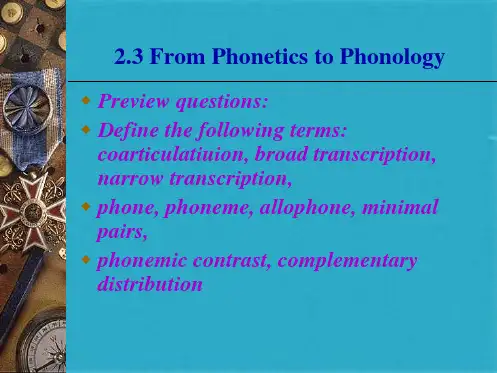
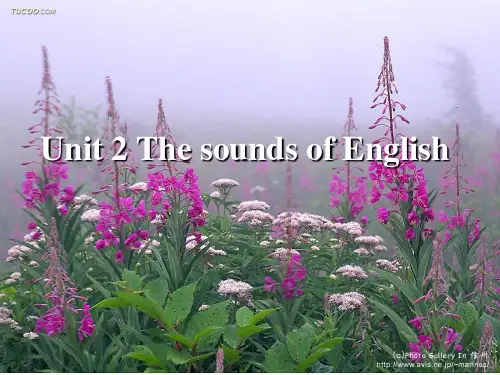
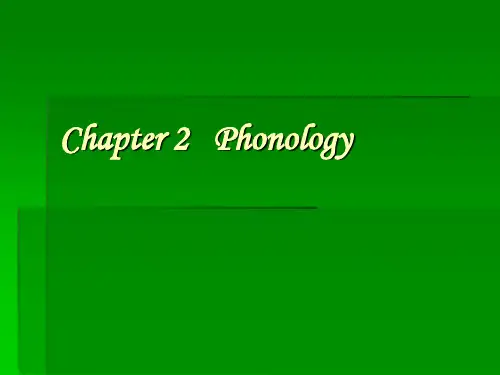
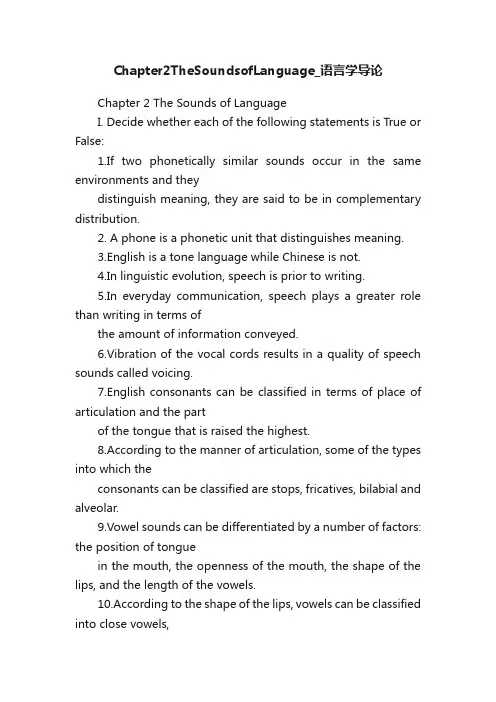
Chapter2TheSoundsofLanguage_语言学导论Chapter 2 The Sounds of LanguageI. Decide whether each of the following statements is True or False:1.If two phonetically similar sounds occur in the same environments and theydistinguish meaning, they are said to be in complementary distribution.2. A phone is a phonetic unit that distinguishes meaning.3.English is a tone language while Chinese is not.4.In linguistic evolution, speech is prior to writing.5.In everyday communication, speech plays a greater role than writing in terms ofthe amount of information conveyed.6.Vibration of the vocal cords results in a quality of speech sounds called voicing.7.English consonants can be classified in terms of place of articulation and the partof the tongue that is raised the highest.8.According to the manner of articulation, some of the types into which theconsonants can be classified are stops, fricatives, bilabial and alveolar.9.Vowel sounds can be differentiated by a number of factors: the position of tonguein the mouth, the openness of the mouth, the shape of the lips, and the length of the vowels.10.According to the shape of the lips, vowels can be classified into close vowels,semi-close vowels, semi-open vowels and open vowels.II. Fill in each of the following blanks with one word which begins with the letter given:1.Of all the speech organs, the t ____ is the most flexible, and is responsible forvarieties of articulation than any other.2.English consonants can be classified in terms of manner of articulation or in termsof p_______ of articulation.3.When the obstruction created by the speech organs is total or complete, the speechsound produced with the obstruction audibly released and the air passing out again is called a s________.4.S_________ features are the phonemic features that occur above the level of thesegments. They include stress, tone, intonation, etc.5.The rules that govern the combination of sounds in a particular language arecalled s____ rules.6.The transcription of speech sounds with letter-symbols only is called broadtranscription while the transcription with letter-symbols together with the diacritics is called n_________ transcription.7.When pitch, stress and sound length are tied to the sentence rather than the wordin isolation, they are collectively known as i_________.8.P___________ is a discipline which studies the system of sounds of a particularlanguage and how sounds are combined into meaningful units to effect linguistic communication.9.T_______ are pitch variations, which are caused by the differing rates of vibrationof the vocal cords and which can distinguish meaning just like phonemes.10.Depending on the context in which stress is considered, there are two kinds ofstress: word stress and s_________ stress.III. Define the terms below:1. phoneme2.allophone3. International Phonetic Alphabet4. intonation5. auditory phonetics6. acoustic phonetics7. minimal pairIV. Answer the following questions as comprehensively as possible. Give examples for illustration if necessary:1.What are the major differences between phonology and phonetics?2.Illustrate with examples how suprasegmental features can affect meaning.3.In what way can we determine whether a phone is a phoneme or not?Suggested AnswersI. 1. F 2. F 3. F 4.T 5. T 6. T 7. F 8. F 9. T 10. FII.1. tongue2. place3. stop4. Suprasegmental5. sequential6. narrow7. intonation8. Phonology9. Tone 10. sentenceIII.1.Phoneme: The basic unit in phonology is called phoneme; it is a unit of distinctivevalue. But it is an abstract unit. To be exact, a phoneme is nota sound; it is a collection of distinctive phonetic features.2.Allophone: The different phones which can represent a phoneme in differentphonetic environments are called the allophones of that phoneme.3.International phonetic alphabet: It is a standardized and internationally acceptedsystem of phonetic transcription.4.Intonation: When pitch, stress and sound length are tied to the sentence rather thanthe word in isolation, they are collectively known as intonation.5.Auditory phonetics: It studies the speech sounds from the hearer's point of view. Itstudies how the sounds are perceived by the hearer.6.Acoustic phonetics: It studies the speech sounds by looking at the sound waves. Itstudies the physical means by which speech sounds are transmitted through the air from one person to another.7.Minimal pair: When two different forms are identical in every way except for onesound segment which occurs in the same place in the strings, the two words are said to form a minimal pair.IV.1. They differ in their approach and focus. Phonetics is of a general nature; it isinterested in all the speech sounds used in all human languages: how they are produced, how they differ from each other, what phonetic features they possess, how they can be classified. Phonology, on the other hand, is interested in the system of sounds of a particular language; it aims to discover how speech soundsin a language form patterns and how these sounds are used to convey meaning in linguistic communication.2. 1) The location of stress in English distinguishes meaning, such as `import andim`port. The similar alternation of stress also occurs between a compound noun and a phrase consisting of the same elements.A phonological feature of the English compounds, is that the stress of the word always falls on the first element and the second element receives secondary stress, for example: 'blackbird is a particular kind of bird, which is not necessarily black, but a black `bird is a bird that is black.2) The more important words such as nouns, verbs adjectives, adverbs, etc. arepronounced with greater force and made more prominent. But to give special emphasis to a certain notion, a word in sentence that is usually unstressed can be stressed to achieve different effect. Take the sentence “He is driving my car.” for example. To emphasize the fact that the car he is driving is not his, or yours, but mine, the speaker can stress the possessivepronoun my, which under normal circumstances is not stressed.3) English has four basic types of intonation, known as the four tones: Whenspoken in different tones, the same sequence of words may have different meanings. Generally speaking, the falling tone indicates that what is said is a straight-forward, matter-of-fact statement, the rising tone often makes a question of what is said, and the fall-rise tone often indicates that there is an implied message in what is said.3. A basic way to determine the phonemes of a language is to see if substituting onesound for another results in a change of meaning. If it does, the two sounds then represent different phonemes.。
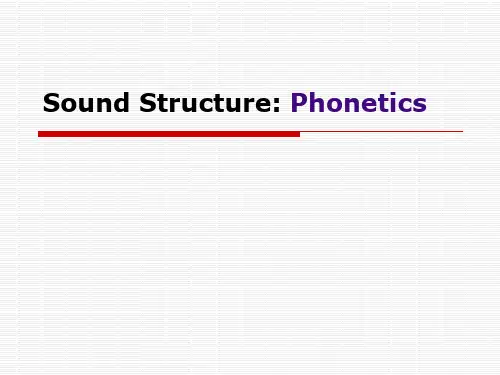
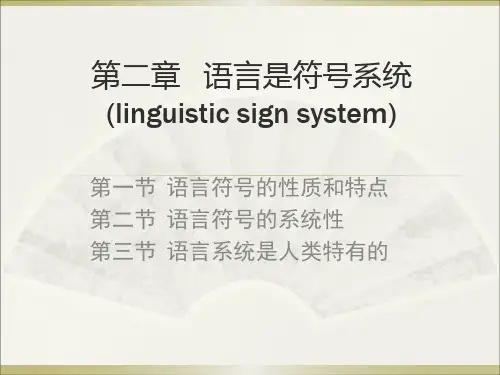

语言学chapter2Chapter 2 phonology1,what are the two major media of communication? Of the two, which one is primary and why?The two major media of communication are speech and writing. Speech is more basic than writing. Because the writing system of any language is always “invented” by its users to record speech when the need arises, and in everyday communication, speech plays a greater role than writing in terms of the amount of information conveyed, speech is always the way in which every native speaker acquires his mother tongue, and writing is learned and taught later when he goes to school.2.What is voicing and how is it caused?Vibration of the vocal cords results in a quality of speech sounds that is called voicing. It is caused by vocal cords which may also be held together tightly so that the air stream vibrates hem at different speeds .3.Explain with examples how broad transcription and narrow transcription differ.Broad transcription is the transcription with letter-symbols only. Narrow transcription is the transcription with letter-symbols together with the diacritics,which are added to the letter-symbols to bring out the finer distinctions than the letters alone can possible do. For example, in broad transcription, the symbol[l]is used for the sound[l]in the four words leaf[li:f],feel[fi:l], build[bild],and health[helθ]. As a matter of fact, the sound [l]in all these four sound combination differ slightly. The [l]in[li:f], occurring before a vowel, is called clear[l], and no diacritic is need to indicate it; the [l]in[fi:l]and[bild]occurring at the end of a word or before another consonant, is pronounced differently from the clear [1] as in “leaf”. It is called dark [?] and innarr ow transcription the diacritic [?] is used to indicate it. Then in the sound combination [helθ], the sou nd [l] is followed by the English dental sound [θ], its pronunciation is somewhat affected by the dental sound that follows it. It is thus called a dental [l], and in narrow transcription the diacritic [、] is used to indicate it. It is transcribed as [helθ]. Another example is the consonant [p]. In the word pit, the sound [p] is pronounced with a strong puff of air, but in spit the puff of air is withheld to some extent. In the case of pit, the [p] sound is said to be aspirated and in the case of spit, the [p] sound is unaspirated. This difference is not shown in broadtranscription, but i n narrow transcription, a small raised “h” is used to show aspiratio n, thus pit is transcribed as [ph?t] and spit is transcribed as [sp?t].4.How are the English consonants classified?English consonants can be classified in two ways: one is in terms of manner of articulation and the other is in terms of place of articulation. In terms of manner of articulation the English consonants can be classified into the following types: stops, fricatives, affricates, liquids, nasals and glides. In terms of place of articulation, it can be classified into following types: bilabial, labiodental, dental, alveolar, palatal, velar and glottal.5.What criteria are used to classify the English vowels?Vowel sounds are differentiated by a number of factors: the position of the tongue in the mouth , the openness of the mouth, the shape of the lips, and the length of the vowels. According to which part of the tongue is held highest, vowels may bedistinguished as front, central, and back. And according to the openness of the mouth, vowels can be classified into close vowels, semi-close vowels , semi-open vowels and open vowels. According to the shape of the lips, all the front vowels and the central vowels are unrounded vowels, and all the back vowels, with the exception of[a:],are rounded vowels. According to the length of the sound, vowels can be classified into tense and lax vowels.6. Give the phonetic symbol fro each of the following sound descriptions:(1)voiced palatal affricate:[?] (2)voiceless labiodental fricative:[f](3)voiced alveolar stop: [d] (4)front, close, short: [i](5)back, semi-open, long: [?:] (6)voiceless, bilabial stop: [p]Give the phonetic features of each of the following sounds:(1)[d]: voiced alveolar stop (2)[l]: voiced alveolar liquids(3)[?]: voiceless palatal affricate (4) [w]: voiced bilabial glides(5) [?]: back, close, short (6) [?]: front, open, short7. How do phonetics and phonology differ in their focus of study? Who do you think will be more interested in the difference between, say, [l] and [?], [ph] and [p], a phonetician or a phonologist? Why?Phonetics is of a general nature, it is interested in all the speech sounds used in all human languages. Phonology aims to discover how speech sounds in a language form patterns and how these sounds are used to convey meaning in linguistic communication.The difference between these sounds is what the phonetician are interested in. Because phonology is concerned with the sound system of a particular language, but phonetician isinterested in how they are produced, how they differ from each other, what phonetic features they possess.8. What is a phone? How is it different from a phoneme? How are allophones related to a phoneme?A phone is a phonetic unit or segment. The speech sounds we hear and produce during linguistic communication are all phones. A phoneme is a phonological unit, it is a unit that is of distinctive value. It is an abstract unit. It is not particular sound, but rather it is represented or realized by a certain phone in a certain phonetic context. Allophones are the different phones which can represent a phoneme in different phonetic environments.9. Explain with examples the sequential rule, the assimilation rule, and the deletion rule.Sequential rules refer to the ways the phonemes can be combined. Sequential rules regulate which phonemes can begin a word, end a word, and follow each other. They are rules that govern the combination of sounds in a particular language.For example, if a word begins with a [l] or a [r], then the next sound must be a vowel. That is why [lbik] [lkbi] are impossible combinations in English. They have violated the restrictions on the sequencing of phonemes.The assimilation rule assimilates one sound to another by “copying” a feature of a sequential phoneme, thus making the two phones similar.For example, the [i:] sound is nasalized in words like bean, green, team, and scream. This is because in all these sound combinations the [i:] sound is followed by a nasal [n] or [m].Deletion rule is when a sound is to be deleted although it is orthographically represented.In the pronunciation of such wordsas sign, design, and paradigm, there is no [g] sound although it is represented in spelling by the letter[g]. But in their corresponding forms signature, designation, and paradigmatic, the [g] represented bythe letter g is pronounced. The rule can be stated as: Deletea [g] when it occurs before a final nasal consonant.10. What are suprasegmental features? How do the major suprasegmental features of English function in conveying meaning?Suprasegmental features refer to the phonemic features that occur above the level of the segments.The main suprasegmental features include stress, tone, and intonation.There are two kinds of stress: word stress and sentence stress. The location of stress in English distinguishes meaning. For example, a shift of stress may change the part of speech of a word from a noun to a verb although its spelling remains unchanged.Tones are pitch variations which can distinguish meaning just like phonemes.When pitch, stress and sound length are tied to the sentence rather than the word in isolation, they are collectively known as intonation. English has four basic types of intonation: the falling tone, the rising tone, the fall-rise tone, and the rise-fall tone When spoken in different tones, the same sequence of words may have different meanings.。
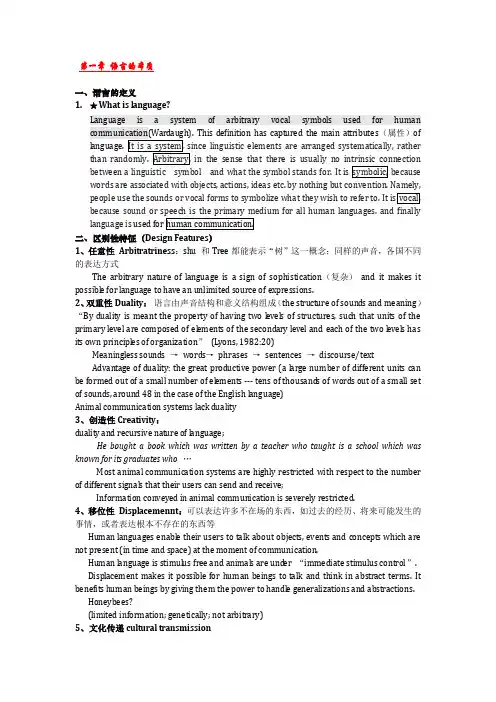
第一章语言的本质一、语言的定义1.★What is language?Language is a system of arbitrary vocal symbols used for human communication(Wardaugh). This definition has captured the main attributes(属性)of language.It is a system, since linguistic elements are arranged systematically, rather than randomly. Arbitrary, in the sense that there is usually no intrinsic connection between a linguistic symbol and what the symbol stands for. It is symbolic, because words are associated with objects, actions, ideas etc. by nothing but convention. Namely, people use the sounds or vocal forms to symbolize what they wish to refer to. It is vocal, because sound or speech is the primary medium for all human languages. and finally language is used for human communication.二、区别性特征(Design Features)1、任意性Arbitratriness:shu 和Tree都能表示“树”这一概念;同样的声音,各国不同的表达方式The arbitrary nature of language is a sign of sophistication(复杂)and it makes it possible for language to have an unlimited source of expressions.2、双重性Duality:语言由声音结构和意义结构组成(the structure of sounds and meaning)“By duality is meant the property of having two levels of structures, such that units of the primary level are composed of elements of the secondary level and each of the two levels has its own principl es of organization”(Lyons, 1982:20)Meaningless sounds →words→phrases →sentences →discourse/textAdvantage of duality: the great productive power (a large number of different units can be formed out of a small number of el ements --- tens of thousands of words out of a small set of sounds, around 48 in the case of the English language)Animal communication systems lack duality3、创造性Creativity:duality and recursive nature of language;He bought a book which was written by a teacher who taught is a school which was known for its graduates who …Most animal communication systems are highly restricted with respect to the number of different signals that their users can send and receive;Information conveyed in animal communication is severely restricted.4、移位性Displacemennt:可以表达许多不在场的东西,如过去的经历、将来可能发生的事情,或者表达根本不存在的东西等Human languages enabl e their users to talk about objects, events and concepts which are not present (in time and space) at the moment of communication.Human language is stimulus free and animals are under “immediate stimulus control”.Displacement makes it possible for human beings to talk and think in abstract terms. It benefits human beings by giving them the power to handle generalizations and abstractions.Honeybees?(limited information; genetically; not arbitrary)5、文化传递cultural transmissionWhile human capacity for language has a genetic basis, i.e., we were all born with the ability to acquire language, the details of any language system are not genetically transmitted, but instead have to be taught and learned. ( culturally transmitted)Animal call systems are genetically transmitted.The general pattern of animal communication is that the signals used are instinctive and not learned.三、语言的功能(Functions of Language)1.传达信息功能Informative:最主要功能The main function2.人际功能Interpersonal Function:人类在社会中建立并维持各自地位的功能people establish and maintain their status in a society with language.3.行事功能performative function:现实应用——判刑、咒语、为船命名等Judge,naming,and cursesto change the social status of persons.4.表情功能Emotive Function:表达强烈情感的语言,如感叹词/句exclamatoryexpressionsa means of getting rid of our nervous energy when we are und er stress.5.寒暄功能Phatic Communion:应酬话phatic language,比如“吃了没?”“天儿真好啊!”等等To create and maintain social relationship between speakers. No factual content is involved. 6.元语言功能Metalingual Function:用语言来谈论、改变语言本身,如book可以指现实中的书也可以用“book这个词来表达作为语言单位的“书”to talk about language itself.7.娱乐功能recreational functionverbal dueling, poetry口头决斗,诗歌四、语言学中几对基本概念的概念区分1. 规定性研究Prescriptive与描述性研究Descriptive●Prescriptive:着重于语言中“标准Standards”认为语言中存在着一种地位最高的语言形态,如标准语法/语音等,为规定人们如何说话、写作●Descriptive:着重于语言中“事实Facts”,目的是描述人们一般是怎样说话、写作的2. 共时研究Synchronic和历时研究Diachronic●Synchronic:以某个特定时期的语言为研究对象,如现代汉语研究、莎士比亚时代语言研究等●Diachronic:研究语言各个阶段的发展变化,研究语言的历史发展规律3.语言Langue和言语Parole(由Ferdinand de Saussure索绪尔提出)●Langue:指语言系统的整体the whole linguistic system,所有语言使用个体头脑中存储的词语-形象word-image的总和,这个整体相对比较稳定●Parole:指代某个个体在实际语言使用环境中说出的具体话语actual use oflanguage,是随时间和地点变化的一个动态的、偶然性很大的实体。
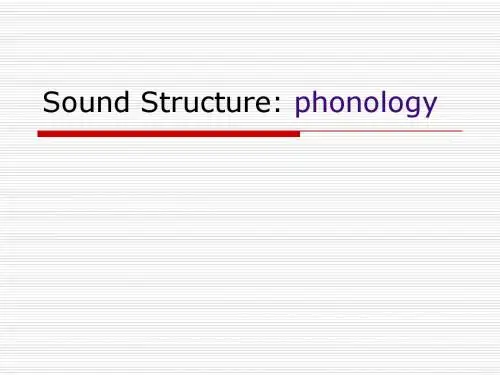
新编语言学导论新编语言学导论是一门综合性的学科,研究语言的起源、结构、演化和使用等方面的问题。
本课程旨在向学生介绍语言学的基本概念、理论和研究方法,帮助学生建立对语言的深入理解和分析能力。
第一章:导论1.1 语言学的定义和研究领域1.2 语言学的历史发展和重要学派1.3 语言学的研究方法和数据来源第二章:语音学2.1 语音学的基本概念和研究对象2.2 语音的产生和感知2.3 语音的分类和描述2.4 语音变体和语音变体学第三章:音位学3.1 音位学的基本概念和研究对象3.2 音位的分类和描述3.3 音位的组合和变体3.4 音位学与音系学的关系第四章:词汇学4.1 词汇学的基本概念和研究对象4.2 词的构成和分类4.3 词的意义和语义关系4.4 词汇的演化和变化第五章:句法学5.1 句法学的基本概念和研究对象5.2 句子的结构和组成5.3 句子的语法关系和句法规则5.4 句法的演化和变化第六章:语义学6.1 语义学的基本概念和研究对象6.2 词义的分类和描述6.3 句义的组成和解释6.4 语义的演化和变化第七章:语用学7.1 语用学的基本概念和研究对象7.2 语用的层次和关系7.3 言语行为和语用推理7.4 语用的演化和变化第八章:社会语言学8.1 社会语言学的基本概念和研究对象8.2 语言变体和社会变量8.3 语言的社会意义和社会身份8.4 社会语言学的应用和研究方法第九章:心理语言学9.1 心理语言学的基本概念和研究对象9.2 语言的认知过程和心理机制9.3 语言的发展和习得9.4 心理语言学的应用和研究方法第十章:语言学研究的前沿和挑战10.1 当代语言学的研究热点和趋势10.2 语言学研究的跨学科合作10.3 语言学研究的伦理和道德问题10.4 语言学研究的未来发展方向本课程将通过理论讲解、案例分析和实践操作等多种教学方法,帮助学生理解和应用语言学的基本原理和方法,培养学生的批判性思维和研究能力,为进一步深入研究语言学或相关学科打下坚实的基础。
英语语言学第二章讲课课件一、教学内容本节课我们将学习英语语言学第二章,主要内容包括:语系与语言分类、语音学与音系学基础、以及词汇学初步。
具体涉及教材第二章的13节,重点探讨语言的起源、语言如何通过语音和词汇表达意义,以及不同语言之间的相似与差异。
二、教学目标1. 理解世界主要语系的特点及其分类依据,能列举至少三种语系并说明其代表性语言。
2. 掌握语音学基本概念,识别不同语音特征,并能在实际语境中进行应用。
3. 运用词汇学知识分析词语构成,提高词汇理解和运用能力。
三、教学难点与重点重点:语音学基本概念、词汇学的主要理论。
难点:语音的发音规则、词汇在不同语境中的应用。
四、教具与学具准备教具:PPT展示、录音机、语音示例CD。
学具:笔记本、词典、语音学基础教材。
五、教学过程1. 导入(5分钟):通过展示世界地图,引入不同地区语言的多样性,激发学生对语言起源和分类的兴趣。
2. 理论讲解(20分钟):介绍语系分类、语音学基础和词汇学构成,结合教材第二章13节内容。
3. 实践情景引入(10分钟):播放不同语言的问候语录音,让学生体验语言差异。
4. 例题讲解(15分钟):讲解语音学中元音、辅音的分类及发音规则,通过例词进行示范。
5. 随堂练习(10分钟):分组进行语音模仿和词汇构造练习。
六、板书设计1. 语系与语言分类印欧语系汉藏语系阿尔泰语系2. 语音学基础元音与辅音发音规则3. 词汇学初步词根、词缀词语构成七、作业设计beautifulunderstand2. 答案:beautiful: beauty, beautifully, beastunderstand: understanding, understandable, misunderstand八、课后反思及拓展延伸1. 反思:关注学生在课堂上的参与度,针对语音模仿环节进行教学调整,提高学生的发音准确性。
2. 拓展延伸:鼓励学生课下阅读更多关于语音学和词汇学的资料,了解语言的发展趋势及其背后的文化因素。